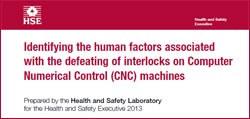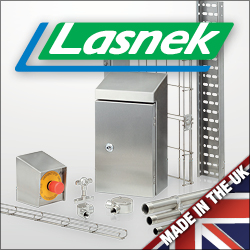
Posted to News on 27th Jun 2013, 20:37
Report: why CNC machine operatives defeat guard interlocks
The Health and Safety Laboratory (HSL) was recently commissioned by the Health and Safety Executive (HSE) to carry out research into why operatives defeat interlocks on computer numerical control (CNC) machines, and to understand the extent of this behaviour across the UK engineering industry. Designers of other types of machinery could also benefit from studying the report.

Findings from this two-year project provided a number of valuable insights about the frequency with which interlocks are defeated and the underlying influences. In particular, poor machine design was identified as a major factor influencing operatives' behaviours. Guards were often considered to be impractical, hampering operatives' ability to do their job.
With regard to frequency of defeating, semi-CNC machines were identified as being commonly defeated in the sample* used in this research. Common activities associated with defeating interlocks were setting, proving, swarf removal and deburring. Managers, supervisors and operatives felt that defeating the interlocks was commonplace (the 'norm'). The most common means of defeating a guard interlock was the use of an override/dummy key in the mechanical switch; other techniques included removing the switch or actuator, and removing the guarding altogether.
Although interlocks were perceived as necessary for operatives' safety and for general housekeeping, the guards supplied as standard on some types of machine were often regarded as unusable and impractical. Machine design (eg poor visibility) and task requirements (eg manufacturing unusually shaped components) were identified as primary reasons for defeating safety interlocks. Guards on some machines were often considered to be there only to protect the machine designers/manufacturers legally, rather than to protect the operatives' health and safety.
Three sets of influences on operative behaviour were identified as influencing behaviour in relation to defeating interlocks: predisposing, enabling and reinforcing.
Interventions that take into account these influences could be developed to promote behaviour change. Suggestions for such interventions are provided within the report. For example, improving the design and manufacture of interlocks/guards and machines could prove valuable. Manufacturers should also consider the use of guards that are more damage-resistant to help improve visibility of the machining process, and video cameras could help improve visibility of the machining process - though these would need to be similarly damage-resistant.
Follow the link to download a copy of the HSE Research Report reference RR974, Identifying the human factors associated with the defeating of interlocks on Computer Numerical Control (CNC) machines (2.24MB PDF).
* Note that the findings are from small-scale qualitative research among small and medium-sized companies and may not generalise to CNC machine users in the UK engineering industry.
Health and Safety Executive (HSE)
(1G) Redgrave Court
Merton Road
L20 7HS
UNITED KINGDOM
+44 (0)845 345 0055


















